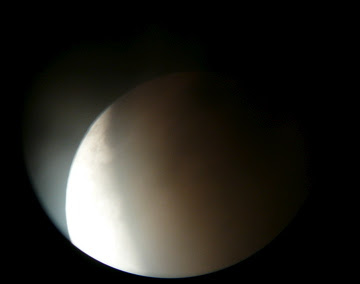So in honor of my sister Kathryn, who did not think awry was a word, I am doing a special blog on a certain animal. The aye-aye.

This animal is well, a little strange looking. It's real name is Daubentonia madagascariensis. As you might guess from it's species, its a native of Madagascar. It is the largest
nocturnal primate. Being a primate it has posable thumbs, but another interesting trademark of the aye-aye is it's exceptionally long middle finger.

It's middle finger can be up to three times longer than the rest of its fingers! Wow! Talk about flipping someone off!
The aye-aye is considered to be an omnivore. It chews holes in wood and uses it's elongated fingers to dig out any grubs. Eww!

Native villagers believe seeing an aye-aye is a symbol of death mostly because of how scary it looks. To counteract this bad omen one must kill the aye aye.

This, along with habitat destruction, has led to the animal being added to the endagered species list.
 A total lunar eclipse happens when the moon passes through Earth's shadow. It will appear as though the Earth's shadow is "eating" the moon.
A total lunar eclipse happens when the moon passes through Earth's shadow. It will appear as though the Earth's shadow is "eating" the moon.  The redness is caused by sunlight being refracted off Earth's atmosphere and onto the moon. The next total lunar eclipse will not happen until 2010 and the next total solar eclipse will not happen until 2017! Since I had the telescope out I thought I would check out Saturn.
The redness is caused by sunlight being refracted off Earth's atmosphere and onto the moon. The next total lunar eclipse will not happen until 2010 and the next total solar eclipse will not happen until 2017! Since I had the telescope out I thought I would check out Saturn.  The little dot to the left of the moon is Saturn. Saturn is mostly made up of gases, 98% helium and hydrogen. At the core, the pressure is so intense that it turns the gaseous hydrogen into liquid metallic hydrogen! Woah! Saturn is like Jupiter in that it has many storms and high winds created from the rising heat off the planet. Through the telescope you can see the rings, some strips on the planet and a couple of it's six medium sized moons. Saturn's rings were discovered in 1610 by Galileo. They stretch a whopping 100,000 miles across, but are only a 100ft thick! The rings are mostly made of frozen chunks of ice, talk about a slushy! There are several moons that are considered "shepherd moons" because their gravity influences the shape of the rings.
The little dot to the left of the moon is Saturn. Saturn is mostly made up of gases, 98% helium and hydrogen. At the core, the pressure is so intense that it turns the gaseous hydrogen into liquid metallic hydrogen! Woah! Saturn is like Jupiter in that it has many storms and high winds created from the rising heat off the planet. Through the telescope you can see the rings, some strips on the planet and a couple of it's six medium sized moons. Saturn's rings were discovered in 1610 by Galileo. They stretch a whopping 100,000 miles across, but are only a 100ft thick! The rings are mostly made of frozen chunks of ice, talk about a slushy! There are several moons that are considered "shepherd moons" because their gravity influences the shape of the rings.  Of course my little camera won't pick that stuff out. In fact it didn't even want to focus on the planet as you can tell. I still enjoyed looking at it though!
Of course my little camera won't pick that stuff out. In fact it didn't even want to focus on the planet as you can tell. I still enjoyed looking at it though!




